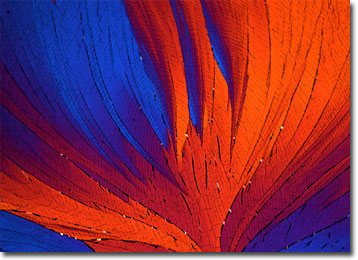Polarized Light Microscopy Digital Image Gallery
Captafol
Captafol is a synthetic fungicide that was introduced in 1961 by the Chevron Chemical Company under the trade name Difolatan. However, the substance, which is commonly utilized in many other parts of the world, has not been legal to sell in the United States since the mid-1980s.

Powerful and effective, captafol can control most fungal diseases that commonly attack plants except the powdery mildews. The substance has gained most use as a combatant of fruit diseases, and is often applied to apples, cranberries, pineapples, strawberries, watermelons, and a wide array of other crops. Captafol has also been utilized as a seed protectant for peanuts, cotton, and rice, and as a fungicide in the timber industry, helping to reduce losses from wood rot fungi. Available in a wide variety of formulations, captafol is compatible with most other types of plant protectants, except those that are strongly alkaline.
Captafol is not overly persistent in soil, its half-life not exceeding 11 days, and does not have a tendency to bioaccumulate. Yet, some studies suggest that the chemical is a potential carcinogen and highly toxic to aquatic organisms. The potential contamination of water bodies through drift and runoff is a particularly great concern since fish kills have already been associated with use of the fungicide. Humans may become exposed to captafol through contact, inhalation, and ingestion. Although acute oral toxicity is low, chronic exposure to the fungicide can lead to hypertension, dermatitis, conjunctivitis, anemia, and a decline in liver function.
